 Royal Navy – Escort Aircraft Carriers (1942-44)
Royal Navy – Escort Aircraft Carriers (1942-44)HMS Slinger, Atheling, Emperor, Ameer, Begum, Trumpeter, Empress, Khedive, Speaker, Nabob, Premier, Shah, Patroller, Rajah, Ranee, Trouncer, Thane, Queen, Ruler, Arbiter, Smiter, Puncher, Reaper
The 23 Ameer (Ruler) class CVE (escort carriers), alongside with the 11 Attacker and 3 Avengers, made the largest bulk of escorts carriers in the Royal Navy alongside the Merfchant Aicraft Carriers (MAC) and locally converted ships such as Audacity, Activity, Pretoria Castle, Vindex, Nairana, Campania, and Archer. The Ameer class were former US-built Bogue class escort carriers, themselves former MARCOM civilian C3 cargo ships ordered in 1940, laid down in 1941 and completed in 1942-43, transferred the very same day they were commissioned in US service to the Royal Navy, renamed and put to British standards.
They brought each up to 24 aicraft to cover the Atlantic convoys from south American to the Arctic routes. Given the fact they were commissioned a bit later than the Attacker class, between July 1943 and February 1944 their usefulness rapidly decreased, but they took part also in Landings on various theaters of war, and escorted convoys or operated in hunter killer groups, semi-independently from the Indian Ocean to later the far east and Pacific, awarded multiple battle honors. Slinger was damaged by a ground mine which exploded under the engine room in 17 fathoms on 5.2.44, and was out of action for 83 months.
Nabob was torpedoed by U354 in the vicinity of one of the bomb rooms, and 150ft of her side was open to the sea, but she was later able to steam 1090nm to port at 10kts under her own power. She was not considered worth repairing and the same was the case with Thane, immobilised by a damaged shaft from a torpedo fired by U482 near the Clyde Lightvessel. It would appear that protection had been much improved compared with Avenger. All but Nabob and Than were thus returned to the US in 1946 and those not scrapped were reconverted as merchants and stated a new civilian life. #ww2 #atlanticbattle #uboats #escortaicraftcarrier #hmsameer #worldwartwo #royalnavy
In short: 23 Lend-Lease Bogue class
Together with the US Bogue class, the Attackers were one of the three mass-produced C-3 type cargo hull escort aircraft carriers, together with the prototype HMS Archer, and the Avenger and Attacker classes. They made the bulk of the Royal Navy escort carrier force, as local shipyard were unable to built or convert more ships, being already at full capacity. The Attacker class was the later result of the acquisition by the USN of twenty-two C3 cargos shortly after the Attack on Pearl Harbor for a convertion into the Bogue class carriers. The need for convoy escorts in the North Atlantic had 23 of them transferred to the Royal Navy under lend-lease, initially part of the Bogue class, and reclassified as Ameer class soon after the transfer of 11 ships reclassed as a Attacker class after their names.
These convoy escort carriers carried an air group which was essentially mission-based, between anti-submarine aircrafts and fighters. They also acted as aircraft transport, transferring new or replacement aircraft to forward bases. Overall this second series of the Bogue class comprised 22 carriers out of 24 built transferred on lend-lease to the RN. A single one went to the RCN, HMS Nabob, manned by RCN crews while under RN flag. More on this on the carrier itself later. One was transferred but remained in the USN. They were many differences from the previous design, as a second series ships they were improved wirth strengthened artillery, increased flight deck but smaller aviation petrol stowage. Their stock 5-inches/50 guns Mk 12 had a limited elevation angle of 27° and only were defensive guns against other ships.
Lend-Lease C3 US-built Escort Carriers
Basically no need for an extensive development description here, as they simply were US-built Bogue class under British lend-lease use. Apart some adaptation to British landing procedures, electronics, they carried basically also a lend-lease and British mixed air group (see later).
The Bogue class is far les known than the Casablancas as US escort carriers, for two reasons.
For once, despite 45 ships converted to that design, only 11 were retained in the US Navy. The rest went to the RN in leand-lease and the second reason was their use in the Atlantic theater whereas the Casablancas were much more present in the Pacific, seeing for some a lot of action like thos of the Taffy 3 at the battle of Samar (Leyte). 45 ships was just 5 vessels shy of the Casablanca class, still.
The Attacker and Ameer class CVEs were respectively 11 and 23 ships, so 34 globally. This was by far the primary escort carrier force used by the RN in its operations, alongside many one-offs, the Audacity, Activity, Vindex class, Archer and Avenger class we already saw.
The common denominator to all these, and still close to the Casablanca class, which were purpose-built as escort carriers, the Bogues emerged from civilian shipyards on the basis standard C3 cargo designation, which vast holds made them suitable for rapid development of internal arrangement below the hangar. They shared all catacteristics of a cargo below the weather deck, being slow and matching the cargo or assault ships they were covering in escort.
They also had a sober and economical machinery for an excellent autonomy and relative ease of repairs, albeit none had diesels or VTE but steam turbines according to US naval standards. The Bogue class themselves derived from USS Charger, close to USS Long Island converted in a hurry by 1940 to reinforce Atlantic escort well before the US were at war in 1941. The base was the same C3 standard cargo. USS Long island improved the design by having a fuller hangar and a proper command bridge whereas Long Island was completely flush deck.
They needed self defence alongside their own air park, and AA guns were placed wherever a spot could be found, namely two 5-in guns for possible surface defensive actions, two twin 40 mm mounts and scores of easy to place 20 m Oerlikon guns. The Bogues, unlike Lend-Lease ships however, had triple expansion engines. All had the same basic deck design, rectangular, stopping short of the bow and stern but wide enough for parking aircraft and land/launch others. Its size prevented simultaneous operation though, despite having one catapult and two elevators fore and aft of the flight deck, on average 141 meters by 21.2 meters.
Lend Lease Transfers
Eleven ships were from Western Pipe and Steel, Ingalls, and Seattle-Tacoma, nine of the first series Bogue/Attacker, one of the second series Bogue/Ruler. They were commissioned between 1942 and 1943. On the Bogue class deployed to protect convoys in the Atlantic, they carried in standard twelve F4F4/FM1/2 Wildcat, nine Grumann TBF/TBM Avengers.
The ships laid down were: USS Altamaha (HMS Battler), Barnes (Attacker), Block Island, Bogue, Breton, Card, Copahee, Core, Croatan, Hamlin, Nassau, USS St. George (Pursuer), USS Altamaha (ii), Prince William (Striker), Barnes (ii), Chatham (Slinger), Glacier (Atheling), Pybus (Emperor), Baffins (Ameer), Bolinas (Begum ), Bastian (Trumpeter), Carnegie (Empress ), Cordova (Khedive), Delgada (Speaker), Edisto (Nabob), Estero (Premier), Jamaica, Keweenaw, Prince (Rajah), Niantic (Ranee), Perdido (Trouncer), Sunset (Thane), St. Andrews (Queen), St. Joseph (Ruler), St. Simon (Arbiter), Vermillion (Smiter), Willapa (Puncher), Winjah (Reaper).
Construction
The Attacker class were built all at Seattle-Tacoma. Some in the Ameer serie were completed on alternative yards still linked to the same yard, like Trouncer and Trumpeter from Commercial Iron Works while Rajah, Singer and Speaker were from Wilamette Iron and Steel. Space was indeed sometimes lacking for completion. This resulted in a remarkable homogenously set of caracteristics which helped with management, maintenance, supply and training.
Design of the class
They had in particular a more powerful catapult capable of launching a 8,500 Ibs aicraft at 73.8 knots, perfect for Avengers in British service, loaded with bombs and rockets in 1945 in the far east. The flight remained overall at 438 feet in some but was larger on others (see details below) and the pretol stowage was rediced to 36,000 gallons except in HMS Begum (34,860 gal.) but also HMS Emeror (48,000) and linger (50,480).
Hull and general design
The Ameer class, like the Attacker/Avenger, differed little from the Bogue class, at least internally. They were identical and quite different from British style accomodations. Waterline length was c465 ft for an overall length of 492 feett 3 inches (versus 495 ft 8 in on the Attackers) or 150 m. Beam was the same 69 ft 6 in (21.18 m) at the waterline and 111 ft 7 in (34 m) on the flight deck level. Draught was deeper than the Attackers at 25 ft 6 in (7.77 m) instead of 24 ft 8 in (7.52 m) fully loaded, probably around 21 ft 2 in (6.5 m) at light load. Standard load displacement was 11,400-11,420 long tons and up to 15,390-15,450t (Atttacker class 14,170 long tons/14,400 t) fully loaded. This also depended on their oil capacity.
The crew comprised 646 officers and ratings like the Attackes and far, far more than a C3 cargo, comprising the air crew. Crew accommodations were typically US and needed the Royal Navy crews to settle. For example food was cooked in a single galley and served in a cafeteria-style central dining area. Also a muxury for RN ships, the Ruler clas CVE came out with with air conditioning, a modern laundry and a barber shop. No hammocks but three-tier bunk beds, 18 to a cabin, hinged and tied up for extra space when not in use. All this made them quite popular to live in.
Powerplant
The Ameer class had a single shaft driven via a common crankhaft by a set of two geared steam turbines, to be precise Allis-Chamber models (General Electric on the Attackers). They were fed each by a single double ended boiler, which liked for the Attacker class were Foster and Wheeler models working at 285 psi (1,970 kPa). The single shaft was of course a liability in terms of redundancy but simplified maintenance. Thius powerplant was rated for 9,350 shp (6,970 kW) instead of 8,500 bhp (6,300 kW), so more than the Attacker class, but still making for a top speed of 17 knots (31 km/h; 20 mph) instead of the 18 knots (33 km/h; 21 mph) or the Attacker and likely 17.5 or more on trials. Sources diverged on this. This was just enough to escape surfaced U-Boats if needed, but at a much reduced range. The generous oil bunkerage averaged 3,160 tonnes for an endurance, for 27,500 nautical miles at 11 knots (48,000 km or 30,000 miles). They could reach any point of the Atlantic and Pacific and even resupply their own escort destroyers if needed.
Armament
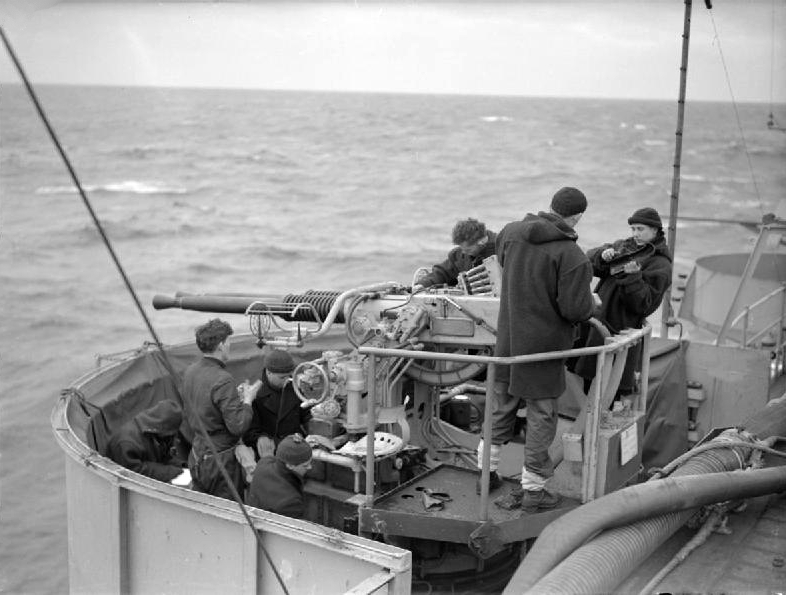
Twin Bofors in HMS Searcher
The Ameer class escort aircraft carriers were to have initially two single mounted 5-inch (127 mm)/51 cal. guns on either side of the stern as built, sponsoned. They were mainly anti-surface guns at 27° elevation and lacking HE shells, poorly optimised against aircraft. However being completed later than the Attackers it seems they were equipped instead with the 5-inches/38. So these were NOT replaced after arrival in Britain by older 4-inch (100 mm)/50 calibre Mk 9 surface guns for ammunitions compatibility as on the Attacker class, as they were shortages.
On this again, sources are contradictory. On wikimedia they turned out ith the 4″/50 caliber gun Marks 10 (likely) which were pure DP guns with a 2,900 ft/s (880 m/s) mv.
The hypothesis of the 5-in/38 Mark 12 is confirmed in many sources showever
5-in/38 Mark 12
⚙ spec. Mark 9 |
|
| Weight | 2 tons barrel & breech |
| Barrel length | 180 inches (4.572 m) bore (45 calibres) |
| Elevation/Traverse | -10 degrees to +30 degrees, arc 180° |
| Loading system | Welin interrupted screw |
| Muzzle velocity | 800 metres per second (2,600 ft/s) |
| Range | 12,660 metres (13,850 yd) |
| Guidance | Optcal, FCS data |
| Crew | |
| Round | 31 pounds (14.1 kg) |
| Rate of Fire | 10-12 rpm |
True AA defence came from eight 40mm (1.6 in) Bofors AA guns in twin mounts two either side on the flight deck corners, plus eight 20-millimetre (0.79 in) Oerlikon AA cannons in twin mounts and ten in single mounts for a start in 1943, all located in sponsons alongsided the deck. But this varied between ships, with HMS Attacker, Chaser, Hunter completed with four single 20 mm AA remainder all twin, Battler had two single, Stalker six single, Fencer seven single 20 mm cannons, Pursuer had four extra 40 mm AA guns, Striker had six extra Bofors replacing twin 20 mm mounts. This imposed reinforcing the sponsons and making them wider.
This changed little over time, as in July 1945 after refit, HMS Arbiter had four single 40mm/56 Bofors Mk I/III added and in August, Trouncer had its fourteen twin 20mm/70 replaced by single 40mm/56 Bofors Mk I/III. Atheling, Emperor, Ameer, Begums, Slinger, Trumpeter, Khedive, Empress, Speaker, Premier, Patroller, Rajah, Ranee, Queen, Ruler, Smiter, Puncher, Reaper in 1945 ended the war with their main DP guns plus their initial eight twin 40mm/60 Mk 1, fourteen twin 20mm/70 Mk 24, plmus seven single 20mm/70 Mk 10.
Arbiter differed in her 20 40mm/60 Mk 1/Mk 3 and 21 20mm/70 Mk 24/Mk 10, Trouncer wit her beefier thirteen 40mm/56 Mk 1/Mk 3, and still seven 20mm/70 Mk 10.
Sensors
It seems unlike the armament, the Ameer, like the Attacker class before kept their US radars, SC, and SG models.
SC Radar:
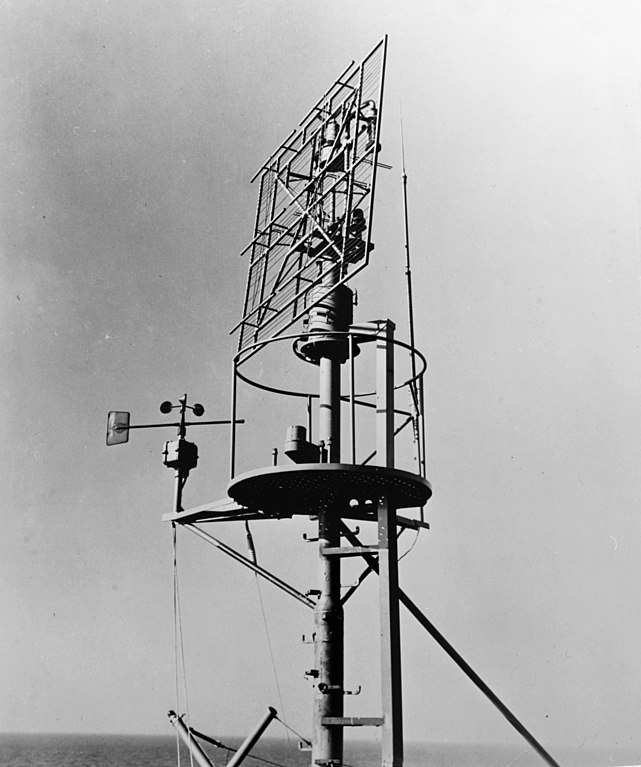
Introduced in 1942 Type Air/Surface-search radar.
Frequency was VHF band, PRF 60 Hz, Beamwidth 10–25°, Pulsewidth 4–5 μs
Range 48–120 km (30–75 mi), Precision 90–180 m (98–197 yd), Peak power 220 kW
SG Radar:
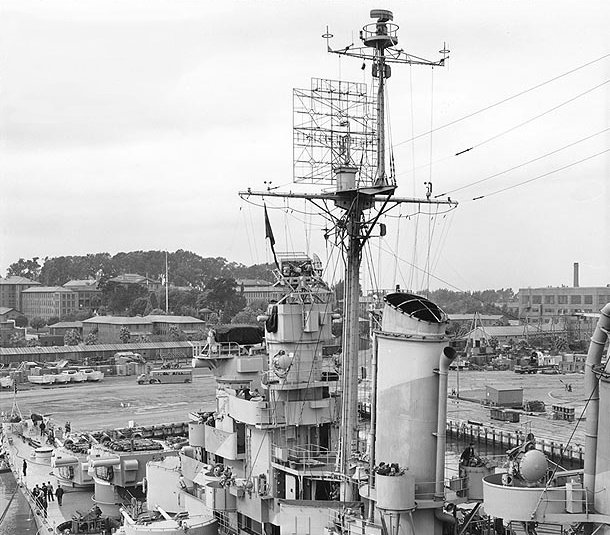
Surface-search radar introduced in 1942, 955 made,
Frequency 3 GHz, PRF 775, 800, or 825, Beamwidth 5.6° (horizontal), 15° (vertical)
Pulsewidth 1.3–2 μs, 4, 8, or 12 rpm
Range 15 nmi (28 km; 17 mi), precision 200 yd (180 m), peak power 50 kW.
The only change was the installation of british radio sets, fire calculator, and HF/DF (“Huff/Duff”) radio direction finders (RDF) installed.
Air Facilities
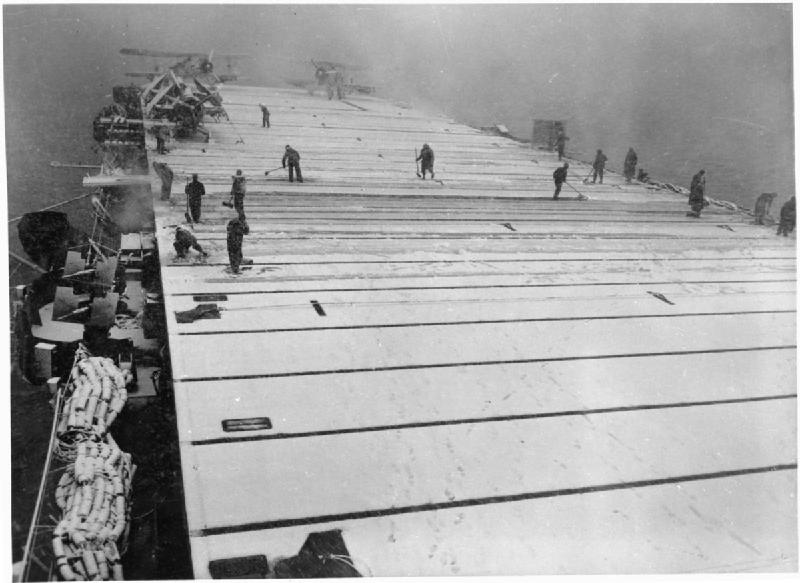
HMS Fencer’s flight deck being cleared from snow during an arctic winter convoy in 1944
Apart their large fight deck that measured 438 ft × 88 ft (133.5 m × 27 m)*, and still had the same small combined bridge–flight control starboard as the previous classes. This also had a map room, staff room, open bridge to control operations, fire control, and pole mast with communication antennae and radars. *The flight deck was only longer at 137.2 m on Smiter.
The hangar deck measured 260 ft × 62 ft x 17.5 ft (79.2 x 18.9 x 5.33m versus 80 m × 19 m x 5.50 m on the Attacker class). The camber at the bow and stern still prevented to make it larger.
They had two elevators measuring the same, 12.6 x 10.1 m (39 x 32 ft), 6.3t capacity placed at both ends of the flight deck (the same as on the Attacker class), with pulleys were required for handling planes on and off these on the hangar deck, difficult in normal conditions and near impossible in rough seas.
The deck had nine arresting wires and three barriers at the stern plus a much better hydraulic catapult H-IV capable of launching a 3.9t plane at 137km/h (versus Attackers the H-II which could only send a 3.2 t plane at 113 kph) at the bow. Normal avgas stowage was, 164,000 liters. so less than the Bogue or Attacker class (versus 186,286 US gal/689,000 liters) although avgas was later reduced on the Attacker at 44,800 imp gal. HMS Begum still carried 158,000 liters and HMS Emperor 218,000 liters, HMS Slinger even had 229,000 liters.
Deck Markings included yellow bands over a dull dark grey dlight deck: One band marking the flight deck forward lip, another for the aft lip, and three dotted lines running parralel along the deck from stern to bow.
Air Group
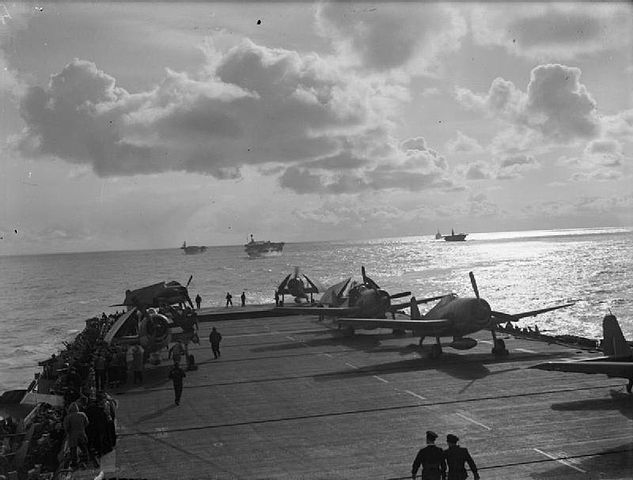
Hellcats on board HMS Emperor during Operation Tungsten in April 1944, the first carrier raid on Tirpitz. Other carriers can be seen in the background as she operated with Victorious, Furious, Fencer, Pursuer and Searcher. Barracudas were used to pound the battleship (this was a failure) and Hellcats provided a large CAP against possible Luftwaffe attacks.
The complement was standard and miss-oriented with a capacity of 18 up to 24 aircraft all storagble in the hangar if needed. This as always included spares. Initially like the Attacker class they were supposed to carry and operate British as well as lend-lease aicraft: The Fulmar, Sea Hurricane, Seafire, Swordfish, Albacore, Barracuda. However in reality, shortages were compensated by a more likely air group composed of US-built lend lease models such as the Martlet/Wildcat, Corsair, Gannet/Hellcat and Tarpon/Avenger torpedo bombers. The latter felt “at home” despite the smaller decks dur to the more powerful catapult.
Some examples:
HMS Emperor started service in December 1943 with already ten Gannet (later called Hellcats when transferred in the Pacific) on board. When in “full fighter mode”, 20-22 Hellcats were carried in mid-1944. A mixed group generally included Wildcats and Avengers (Begum, Shah summer 1944). Other had less modern models such as HMS Ameer, completed earlier as Trumpeter, combining 4 Martlet (Wildcats) with 8-12 Avengers. At thsis juncture, few carried british models, the exception being HMS Atheling which by mid-1944 combined 10 Wildcat and 10 Seafire. The first as escorts, the second as interceptors and CAP.
Another case was HMS Emperor by late 1944, seen with 20 Hellcat, a single Swordfish (for recce/ASW) and a single Walrus for Recce and liaison to shore.
Amazingly, Wildcats were still carried until the end of the war, like on HMS Queen by mid-1945. By 1945 with the BPF in the Pacific these carriers were mostly used for strikes and carried generally only Hellcats, including night fighter versions, all fitted with rocket racks underwings. This range from 18 to 24 on average. Walruses were also carried until the end. Corsairs were pretty rare.
Supermarine Seafire

MkIII, NN 344/K-O,’Jane’ 899 NAS, HMS Khedive, Aegean, Summer 1944
There are photos one those of HMS Ameer, Atheling, Khedive, Smiter here. On Ameer these were F.Mk.IIIC. On HMS Khedive these were F Mk.IIIs of Sqn 899, some armed with bombs and with good quality photos.
Colour photo for reference, Khedive Malta July 1944.
Another seafire, not these carriers, but just glorious photo
Martlet/Wildcat
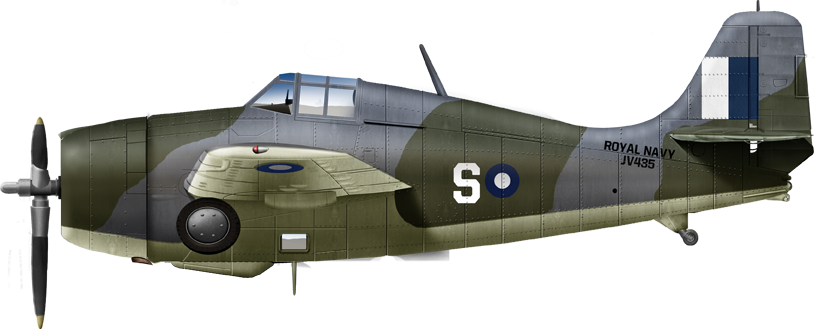
Wildcat Mark IV 890 NAS HMS Atheling 1945
Gannet/Hellcat
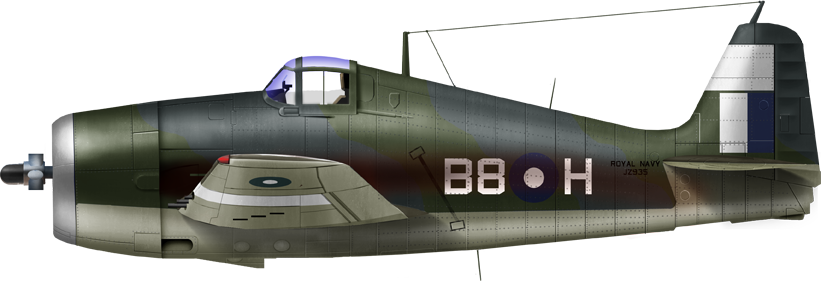
Hellcat Mark II 895 Sqn NAS HMS Empress 1945
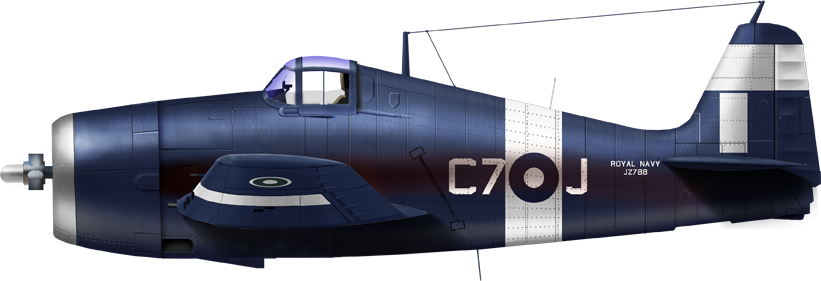
Hellcat F-II 808 Sqn. HMS Khedive 1945
Tarpon/Avenger
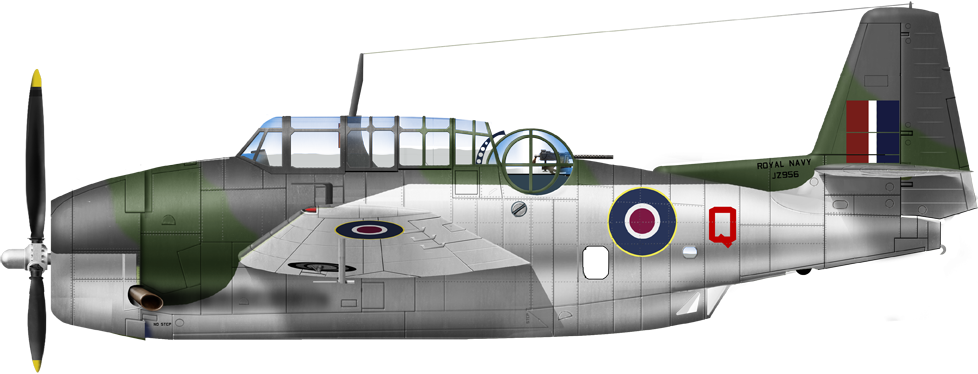
Tarpon Mark II 853 NAS FAA HMS Queen 1945
Pecularities
Naming Conventions
Historians had the class named after HMS Ameer, which had the first pennant in serie, R302, was first in alphabetic order, and and first transferred in July 1943. But another popular name, egnerally accepted in the literrature, is “Ruler” due to the naming convention chosen for this class. The idea for these ships was to “rule” the seas, especially the Atlantic as generally intended. All names were indeed linked to various authorities names, in several cultures, up to “HMS Queen” with some exceptions like reaper, slinger, smiter, troucer and trumpeter (see the 1st group below).
A sub-class from HMS Smiter ?
One source, royalnavyresearcharchive.org.uk separates the Ameer (17 ships) from the Smiter class (6 ships) not based on their caracteristics but names:
Ameer: A second batch of Bogue class vessels, ordered in response to a continued need for escort carriers. Built from the keel up as carriers, these ships were almost identical to the first batch of Bogue conversions. All but one of this batch of ships were to be transferred to the RN.
Smiter: A sub class of the second batch of Bogue class vessels named with aggressive action names, possibly carried over from the ATTACKER Class.
Carriers fitted for ASW and strike operations
There were however two groups in the class, the first included 8 ships and indeed, HMS Smiter but also HMS Patroller, Puncher, Reaper, Slinger, Speaker, Trouncer and Trumpeter, all named from leftover of the Attacker class.
The second group comprised HMS Arbiter, Ameer, Atheling, Begum, Emperor, Empress, Khedive, Nabob, Premier, Queen, Rajah, Ranee, Ruler, Shah, Thane.
Carriers fitted for ASW: Smiter, Trumpeter, Atheling, Begum, Khedive, Nabob, Premier, Queen, Shah
Carriers fitted for strikes: Speaker, Ameer, Emperor, Ruler.
Aircraft transport with added strike capability: HMS Patroller, Puncher, Reaper, Slinger, Trouncer, Arbiter, Empress, Rajah, Ranee
Combat Assessment
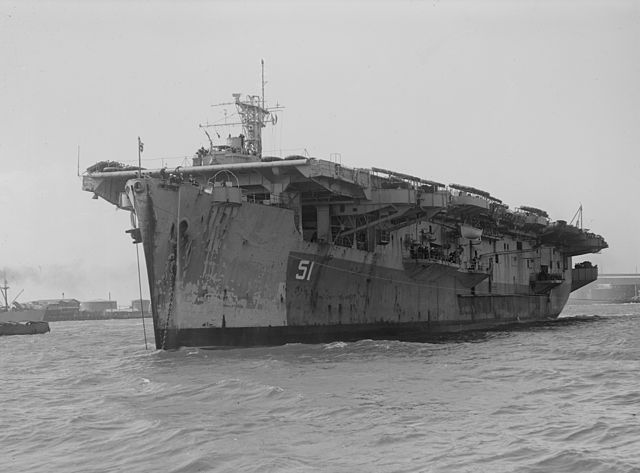
(To come in a future update)
Career of the Amer class
 HMS Slinger (R313)
HMS Slinger (R313)
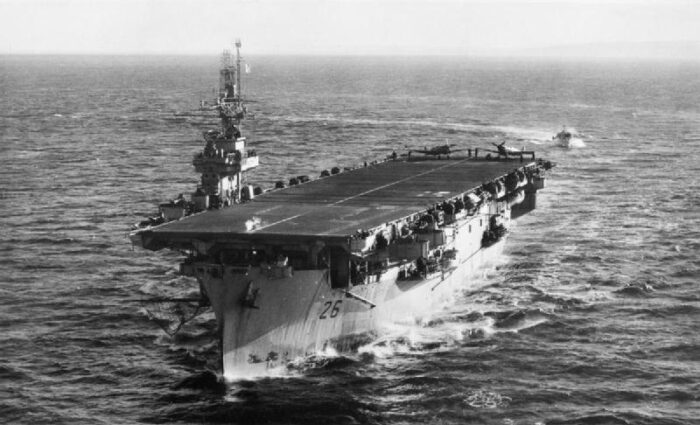
Slinger was the ex-CVE32 Chatham, D26, later R313. She was laid down at yard 27 at Seattle-Tacoma, Willamette Iron and Steel on 25.5.1942, launched on 15.12.1942 and completed on 11.8.1943.
Designated as a transport carrier she hit a mine off Lowestoft on on 5 February 1944 and had long repairs. She was returned to service on 17 October, and worked-up a new crew, then by early-1945, she was sent to Sydney and the British Pacific Fleet as spare aircraft replenishment vessel attached to the 30th Aircraft Carrier Squadron. She received battle honour ‘Okinawa’. She ferried aircraft to and from Brisbane, and was prepared for Olympic but it never came ans after staying inactive in Manus, Philippines, she was sent to Hong Kong by August 1945, a support vessel. In the autumn she made two trips to Sydney with returned POWs. She sailed home via Colombo, Cairo and Gibraltar and arrived in January 1946. She was returned to USA on 27.2.1946.
 HMS Atheling (R304)
HMS Atheling (R304)
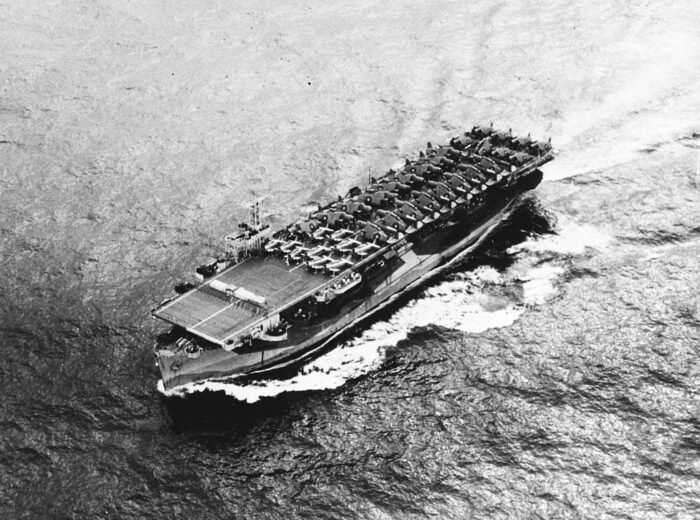
CVE33 USS Glacier was initially laid down at Seattle-Tacoma, on 9.6.1942, launched 7.9.1942, completed on 3.7.1943, transferred on 1.8.1943 as Atheling, D51 and the R304. After her formal transfer to the RN she was sent to the Royal Canadian Navy dockyard at Esquimalt and converted for British use, then commissioned as Atheling on 28 October. She crossed Panama adna arrived in New York to pick up her air group and sailed to the Clyde in January 1944 for further modification to operate fighters. She ferried RN squadrons to the Far East in April 1944 (822, 823 NAS) with Fairey Barracudas, notably at Madras, 11 April. She also transferred 1837 NAS and 1838 NAS with Corsair II at Ceylon on 13 April. On Trincomalee she embarked 1383, 899 NAS ten Corsair and ten Supermarine Seafires for her own air group. This was short as she returned to aircraft ferry duties for both the VPF and US 5th fleet and even troopship. She ended in Norfolk, Virginia, on 6 December 1946, stricken on 7 February 1947, sold to National Bulk Carriers as “Roma”, converted from 26 November 1947, and aftrer anoteher career, sold and scrapped in Italy in November 1967.
 HMS Emperor (R307)
HMS Emperor (R307)
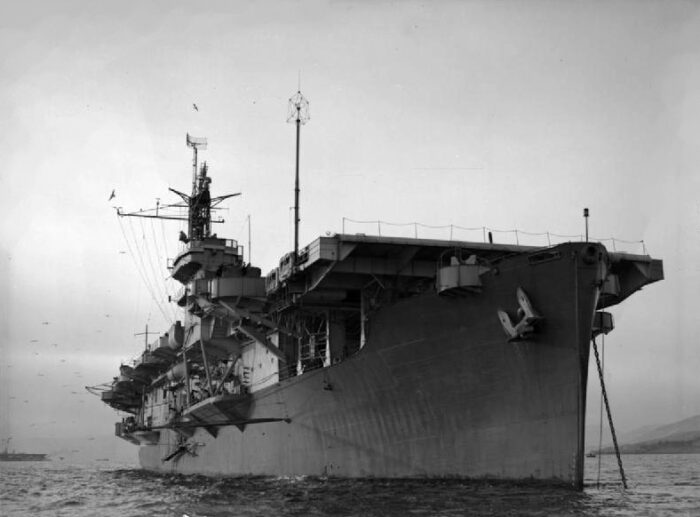
Emperor was laid down as USS Pybus AVG-34, CVE34 (D98) MC Hull No. 245 at Yard 29 in Seattle-Tacoma, on 23.6.1942, ACV-34 on 20 August 1942, launched on 7.10.1942 and completed on 31.5.1943 in Puget Sound Navy Yard, CVE-34 on 15 July 1943, transferred on 6.8.1943. From March to April 1945 she was attached to the 21st Aircraft Carrier Squadron and made her shakedown in the Pacific Fleet decommissioned on 6 August 1943 at New York and later HMS Emperor, D98. She had a rich career comprising prestigious operations such as Operation Tungsten, the attack on Tirpitz (march-april 1944), Operation Overlord (June 1944), Operation Dragoon (August 1944) and in the far east Operation Dracula and Operation Tiderace (1945). She was returned to the USN 12 February 1946, stricken 28 March 1946, sold 14 May to Patapsco Scrap Co., for scrapping.
 HMS Ameer (R302)
HMS Ameer (R302)
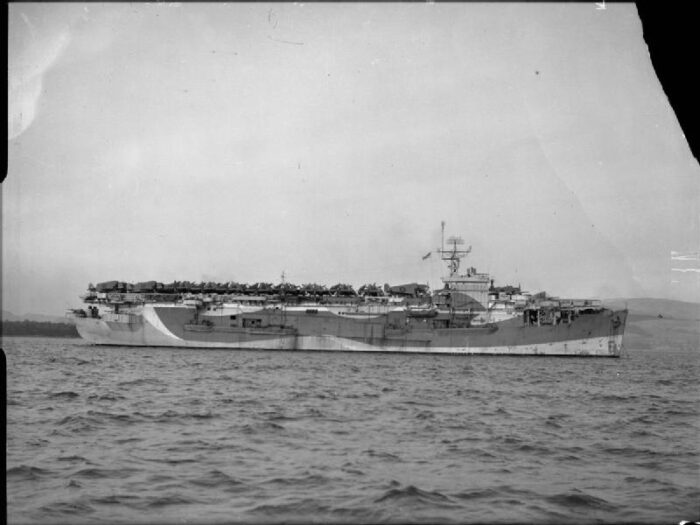
HMS Ameer was initially laid down asACV35 Baffins (D01), Yard 30 in Seattle-Tacoma on 18.7.1942, launched on 18.10.1942 and completed on 28.6.1943, transferred on 20.7.1943. Early on she joined the
British Eastern Fleet, used as convoy escort in May 1944 with KMF-31 to the Mediterranean, buit continued to Trincomalee, Ceylon. She met HMS Battler, HMS Begum, and HMS Shah and went on further east. By early 1945, she joined Force 61 for Operation Lightning, a landing by Commando Brigade, Royal Marine and Army units on Akyab in Burma. They found no opposition as the Japanese evacuated just before. Next she was committed in Operation Matador, the capture of Ramree Island, spotting for the guns of HMS Queen Elizabeth on 21 January 1945. She then covered the 71st and 4th Brigades. Next she was at Operation Sankey, covering the landings at Cheduba Island by Royal Marines.
On 22 February 1945, she left Trincomalee with Force 62 and her sister HMS Empress, escorted by the light cruiser HMS Kenya, six destroyers and six frigates for Operation Stacey, launching photo-reconnaissance missions over Hastings Harbor, Phuket Island and the Kra Isthmus on 26-28 February. Her Hellcats repulsed Japanese aircraft and then covered landings.
In June 1945 she sailed with Force 63 with Khedive, Stalker for Operation Balsam, photo-reconnaissance missions over Malaya.
On 20 June, this was for offensive sweeps of 808 NAS Hellcats joining the 809 Sqn Seafires from another carrier to rampage Lhoksemawe, Medan and Bindjai. One Hellcat was lost to AA.
Her last two operations were to cover mine-sweepers with HMS Emperor, Nigeria, the DDs HMS Roebuck, HMS Eskimo and HMS Vigilant at the Nicobar Islands (9-10 July). She was in Operation Livery on 24 July, off Phuket Island and Kra Isthmus with HMS Nelson. On 26 July she sortied with TF 63 when hit by kamikaze attacks sinking HMS Vestal.
She was returned to the US at Norfolk on 17 January 1946, stricke sold as merchant Robin Kirk on 17 September 1946, scrapped in Taiwan in 1969.
 HMS Begum (R305)
HMS Begum (R305)
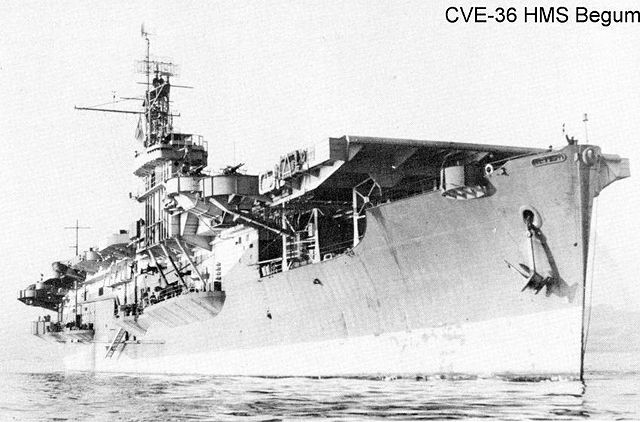
Begum was laid down as CVE36 Bolinas, later D38 from Seattle-Tacoma on 3.8.1942, launched on 11.11.1942, completed on 22.7.1943, transferred after modifications on 3.8.1943. She was modified and tailored for anti-submarine sweeps in the Indian Ocean and operated all along with the 832 Squadron, which claimed U-198. Next she started to ferry RN squadrons to the Far East in April 1944, Sqn 1839 and 1844 NAS (10+10 Hellcats) and 815-817 (12+12 Barracuda II) in Madras on 14 April. After her return she was declared surplus when rettuedn to the US, stricken 19 June 1946, sold as the merchant Raki on 16 April 1947 as later resold as I Yung, scrapped in Taiwan in March 1974.
 HMS Trumpeter (R318)
HMS Trumpeter (R318)
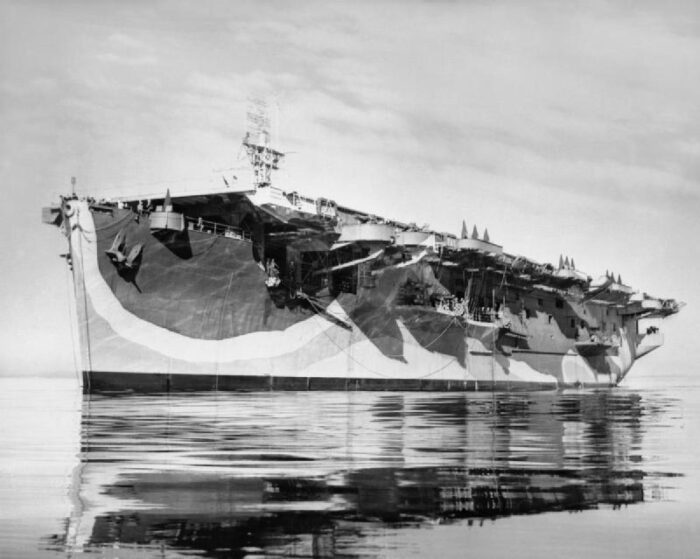
Trumpeter was initially laid down on 25.8.1942 as CVE37 Bastian in Seattle, later after transfer became D09. She was launched on 15.12.1942 and completed on 4.8.1943. On 4 May 1945 she carried the 846 Naval Air Squadron for Operation Judgement, a raid on the U-boat base of Kilbotn, Norway, launching herself eight Tarpons and four Martlet over the 44-aircraft. They notably co-claimed the depot ship “Black Watch” and U-711. No logs for the rest of her career yet. To be completed at a later date. She was returned to the US on 6 April 1946, stricken 19 June 1946 sold as merchant Alblasserdijk, then Irene Valmas), BU in Spain in 1971.
 HMS Empress (D42)
HMS Empress (D42)
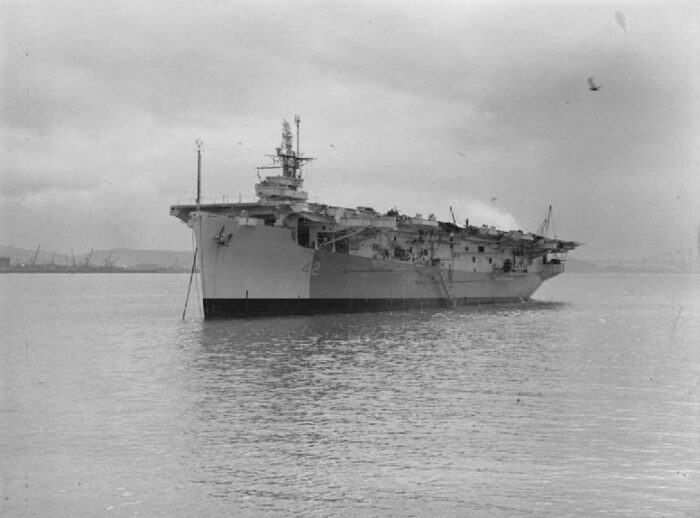
Empress was laid down as CVE38 Carnegie at yard 33 in Seattle-Tacoma on 9.9.1942, launched on 30.12.1942 and completed on 13.8.1943. She served in the Pacific and Indian Oceans mostly as an aircraft transport rather than a carrier and her last mission was in September 1945, Operation Tiderace, covering the reoccupation of Singapore. On 28 January 1946, she was rettuend to the US, stricken on 28 March 1946, sold for scrap 21 June 1946.

An 845 NAS Avenger taking off from HMS Empress off Trincomalee
 HMS Khedive (D62)
HMS Khedive (D62)
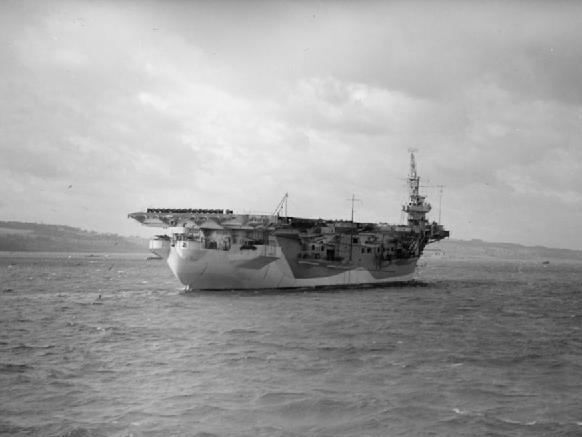
Khedive was laid down as CVE39 Cordova at Seattle-Tacoma on 22.9.1942, launched on 27.12.1942, completed on 23.8.1943 and commissioned with the RN after transformations on 25.8.1943 as an ASW carrier. She served as the command ship for the Operation Anvil in August 1944. From April to August 1945 she took part in several escort and strike missions as part of the East Indies Fleet and 21st Aircraft Carrier Squadron. She was present for the invasion of Singapore in September 1945 (Operation Tiderace) and stayed off the island for security. Returned to the US by 26 January 1946 she was sold as the merchant Rempang (later Daphne) on 23 January 1947, scrapped in Spain by 1975.
 HMS Speaker (R314)
HMS Speaker (R314)
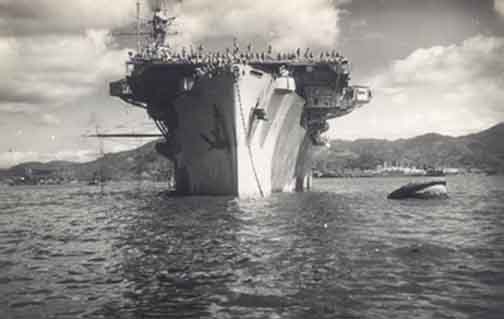
Laid down as CVE40 Delgada at Seattle-Tacoma 9.10.1942, launched 20.2.1943, she was completed at Willamette Iron and Steel on 20.11.1943 and after transfer to the RN became D90, then later R314.
She was converted to British needs. This was done at Burrards at Vancouver and her flight deck was elongated and she received Rying controls and fighter direction layout, hangar modifications and new accommodation and store rooms s well as specific safety measures as well as oiling at sea arrangements and gunnery/internal communications, then British extra wireless and radio facilities but also black-out arrangements. She sailed after a short training to the Panama Canal on 8 March 1944, stopped at Norfolk and to load crated aircraft, stores and passengers in New York, and arrived in Liverpool on 8 March. She escorted a convoy back to the US until 8 April and made a second aircraft ferry run.
On 17 May in Greenock it was decided to convert her further as an assault aircraft carrier at Caledon Shipbuilding & Engineering Company in Dundee. She was to received Hellcats from 1840 Naval Air Squadron and acted as training carrier from 16 October to 14 December, with 1,500 landings made by Fairey Barracuda, Swordfish and Helldivers.
With Squadron 1840 aboard, all Hellcat III fitted with rocket racks underwings and rockets stored, she saled for Gibraltar, Mediterranean in January 1945 with HMS Slinger, Khedive making ASW patrols off North Africa and joined the Eastern Fleet at Colombo after a stop at Alexandria and Aden. During training she lost a pilot in the Red Sea.
At Colombo on 4 February, Speaker and Slinger were prepare to operate with the new BPF HQ at at Sydney. Underway tjey looked for a reported missing troopship, arriving on 23 February. She lost 8 Hellcats transferred as replacemnts HMS Indomitable.
She sailed out on 9 March for Manus Island, 30th Aircraft Carrier Squadron. On 18 March she sailed with Striker and HMS Kempenfelt to provide Combat Air Patrols for the British fuelling area in Operation Iceberg (Okinawa). On 23 May she followed the BPF to Leyte, for replenishment. She transferred to Indomitable most of her aircraft and personel and from then on was ordered as a replenishment carrier, with the “flyable duds” and assigned to repair aircraft and take care of and injured crew. By mid-May she was back at Sydney for R&R.
She was returned to Uncle Sam on 27 July 1946 via Bermuda on 18 July, disembarked the Captain (S.V. Jethson) to take charge of the Establishments HMS Malabar. She was sold as merchant on 22 April 1947, renamed Lancero, later resold as President Osmena in 1965, Lucky One in 1971, scrapped in Taiwan in 1972.
 HMS Nabob (D77)
HMS Nabob (D77)

Nabob was laid down as CVE41 Edisto at yard 36 Seattle-Tacoma on 20.10.1942, launched on 9.3.1943 and completed on 7.9.1943. She was an interesting case, as operating under the British flag but with a RCAN crew. She was in effect the first Royal Canadian Navy aircraft carrier. The goal was to give future carrier groups some base experience in the prospect of the RCN obtaining two Colossus class vessels in 1945, taking its share in operations in the Pacific. But her career was fairly short. In August 1944 however, HMS Nabob was torpedoed by the German submarine U-354 as part of the raid against Tirpitz. She survived the attack and limped back to port. Here, a teaml inspected her and considered too damaged to repair. She thus was patched up summairly and remained in port for the rest of the war until returned to the US. She was one of the two carriers of this class to be reported lost in action. Soon she was to be sold for scrap but instead,fully repairs while converted for mercantile use as Nabob, then Glory, and sold for scrapping in 1977. So that’s a paradox for a ship “sunk by U-354” to have such a long and useful carrer.
 HMS Premier (D23)
HMS Premier (D23)
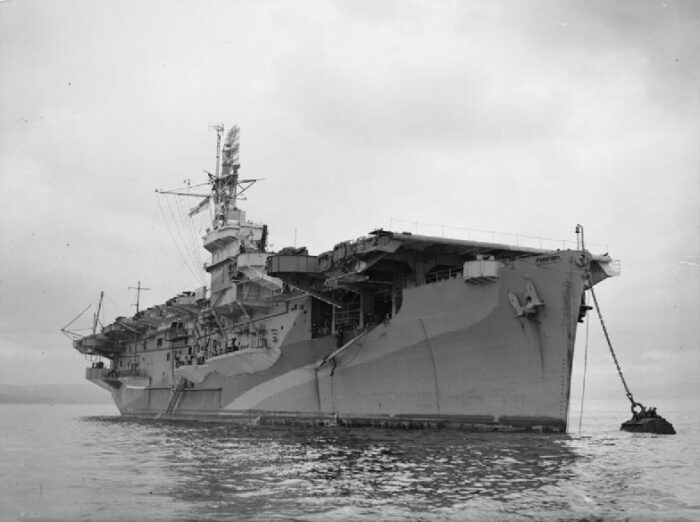
Premier was laid down at Seattle as CVE42 Estero in yard 37 on 31.10.1942. She was launched on 22.3.1943 and completed on 3.11.1943. She served as an ASW escort carrier in European waters and doubled as ferry carrier. She was returned in the US on 2 April 1946, stricken on 21 May 1946, sold as merchant “Rhodesia Star” and later Hong Kong Knight in 1947, scrapped in Taiwan in 1974.
 HMS Shah (R312)
HMS Shah (R312)
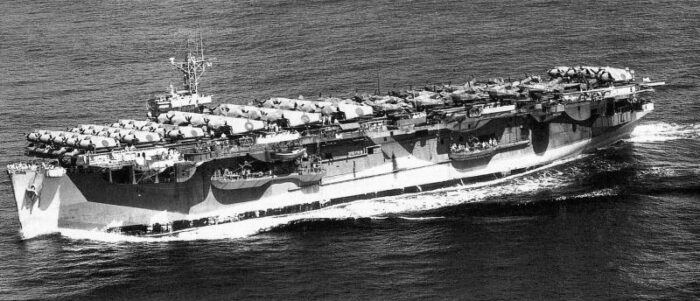
Shah was laid down at Tacoma as CVE43 Jamaica in yard 38, 13.11.1942. She ws launched on 21.4.1943 and completed on 27.9.1943, transferred to the RN as D21, later R312. She was an escort carrier trained and prepared for anti-submarine work and transferred right away to the Pacific under captain William John Yendell and with the 851 Naval Air Squadron (12 Avenger II, Wildcat IV).
She was modified in Canada after trials for convoy defence and left Vancouver for San Francisco and received 12 additional Grumman Avengers and Wildcats in the hangar, while her deck was jam packed with Curtiss P-40s to be ferried to Cochin. She arrived first at Melbourne for resupplying and arrived at Cochin and Colombo.
Next she started a serie of convoy escort missions, looking for U-Boats in the Indian Ocean, from Trincomalee. She was at the head oa her own hunter-killer group, claiming U-198 on 12 August 1944. Sqn 851 Avengers located the submarines and redirected HMS Begum, the frigate HMS Findhorn and sloop HMIS Godavari to be depth charged. She was transferred to the East Indies Fleet and had a refit in Durban for the the Burma campaign in 1945, having aircraft losses and receiving spare Grumman Hellcats. In April-May 1945 she ytook part in Operation Bishop on Nicobar adn before the invasion of Rangoon. She was detached to look after the Japanese cruiser Haguro. Her HIV catapult failed however and her Avengers were transferred to HMS Emperor in exchange for Hellcats of 800 and 804 Squadron. Several were destroyed after a severe landing accident on 11 May. Her former Sqn 851 Avengers from Emperor, located and badly damaged Haguro, later sank by the 26th Destroyer Flotilla in Operation Dukedom.
She was back at Ceylon and Bombay for repairs and refits and recuperate Avengers from 851 and 845 Squadrons, Hellcats and a Walrus to join in August Operation Zipper, Malay coast learning of the capitulation. She diembarked her air group at Trincomalee on 26 August and sailed for the Clyde naval base via Aden and Suez Canal. She was sent to Norfolk on 16 October, handed over to the United States on 26 Novembe, sold into merchant service to Argentina as Salta on 20 June 1947 after conversion at Newport News, assisting in 1963 the Greek liner Lakonia, rescuing 475 people. She was scrapped in Buenos Aires in 1966.
 HMS Patroller (D07)
HMS Patroller (D07)
Patroller was laid down as CVE44 Keewenaw at yard 39 in Seattle-Tacoma on 27.11.1942, launched on 6.5.1943 and completed on 25.10.1943. Sheoperated in the Atlantic as convoy escort and transport carrier for the Army and Navy. She was returne dto the USN at Norfolk on 9 December 1946, struck on 7 February 1947, sold to Waterman Steamship Corp. on 26 August 1947 as Almkerk and later renamed Pacific Reliance, scrapped in Taiwan in 1974.
 HMS Rajah (D10/R310)
HMS Rajah (D10/R310)
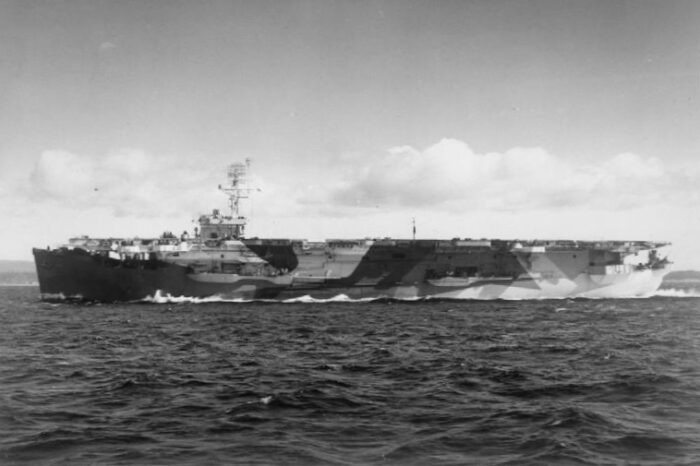
Rajah was the ex-CVE45 Prince and ex-McClure laid down at yard 40 of Seattle-Tacoma on 17.12.1942, launched 18.5.1943 and completed at Willamette Iron and Steel, on 17.1.1944. After her service whe was retutrned to Norfolk on 13 December 1946, stricken 7 February 1947 and purchased by Waterman Steamship Corporation on 7 July, converted as the merchant Drente (Lambros, Ulysses) in 1948, scrapped in Taiwan in 1975.
 HMS Ranee (D03/R323)
HMS Ranee (D03/R323)
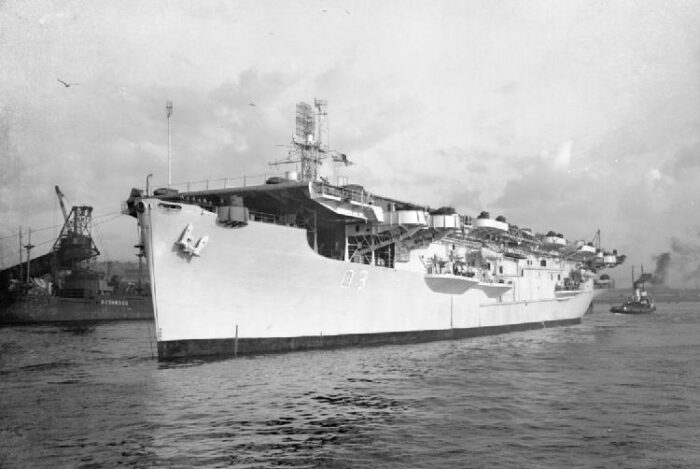
She was started as CVE46 Niantic at yard 41 of Seattle-Tacoma on 5.1.1943 and launched on 2.6.1943. She was completed on 8.11.1943. She was assigned to the Atlantic convoy routes and Western Approaches, patrolling against U-boats in the North Atlantic and the Bay of Biscay. On 27 February 1945 she sailed from San Diego with USMC squadron VMO-7 bound to Pearl Harbor. She served with the Training Squadron, Western Approaches by later 1945, until returned to the US at Norfolk on 21 November 1946, stricken 22 January 1947, sold 9 June 1947 to Waterman Steamship Corp. as Friesland (later Pacific Breeze), scrapped in Taiwan in 1974.
 HMS Trouncer (D85)
HMS Trouncer (D85)
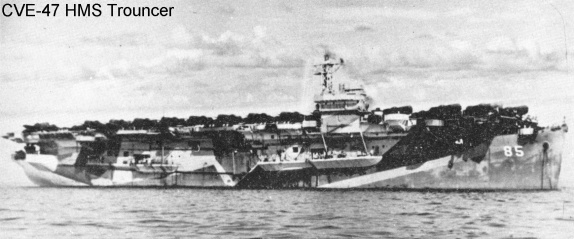
Laid down as CVE47 Perdita at yard 42 in Seattle-Tacoma on 1.2.1943 she was launched on 16.6.1943 and completed at Commercial Iron Works, Portland, on 31.1.1944. She took part in convoy escort and ASW patrol operations and was returned to Norfolk, on 21 February 1946. Renamed Perdido returned to the U.S. Navy 3 March 1946, on 25 March sold for disposal, stricken 12 April 1946. Sold to William B. St. John 6 March 1947 converted as the merchant Greystroke Castle (Gallic in 1954, Berinnes in 1959), scrapped in Taiwan in 1973.
 HMS Thane (D48, R316)
HMS Thane (D48, R316)
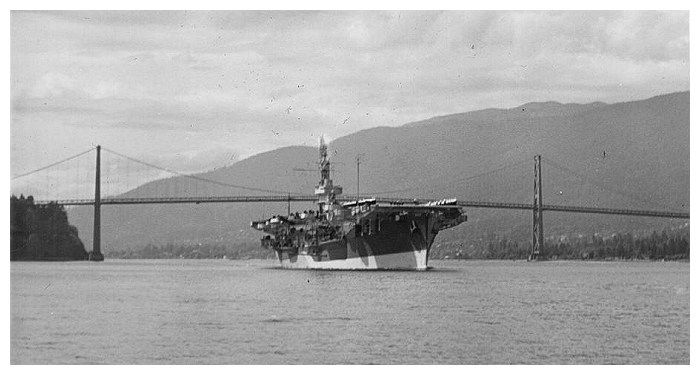
Laid down as CVE48 Sunset at Yard 43 Seattle-Tacoma on 23.2.1943 she was launched on 15.7.1943 and completed on 19.11.1943. She operated in the North Atlantic to cover convoys and ferry aircraft for the European Theater, both army and navy. Her last voyage was to carry the first helicopters to the UK, Nine Sikorsky R-4B Hoverfly from Norfolk in Virginia on 29–30 December 1944. She was delayed by snowy weather during the load. On 15 January 1945, while ferrying aircraft in the Irish Sea, she was torpedoed by the German submarine U-1172 and severely damaged, losing her starboard aft 5 inch gun and its sponson, disabling propulsion, and losing 10 men. On arrival seven helicopters were flown off to RDU Abbotsinch and two were too damaged to take off and were craned off. She was stationed in Taken to Gare Loch, Firth of Clyde to be examined and soon declared a constructive total loss, decommissioned to reserve. Returned to United States on 12 May on paper (still same place). The United States Navy liaison officer considered she was to be sold for disposal in October and scrapped.
 HMS Queen (D19, R320)
HMS Queen (D19, R320)
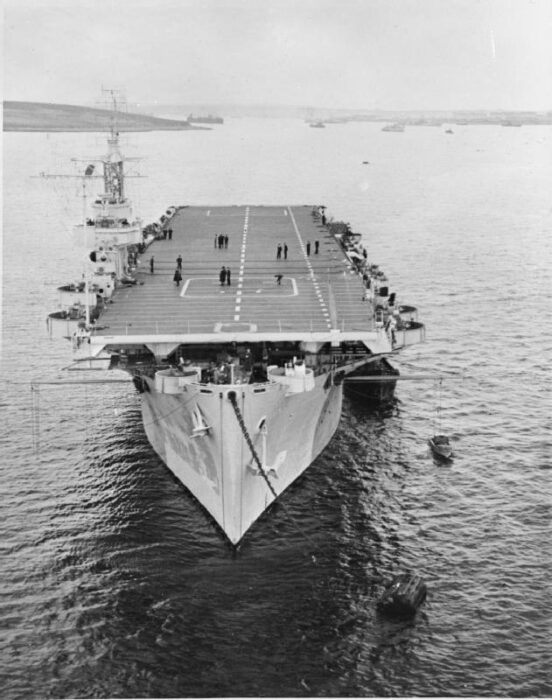
Queen was laid down as CVE49 St. Andrews at Yard 44 in Seattle on 12.3.1943, launched on 31.7.1943 and completed on 7.12.1943. She covered Allied escort convoy in the North Atlantic in 1944, before beign sent to assist the eastern fleet and later BPF in the Pacific taking part in the last campaigns of 1945. On 4 May 1945 she carried the 853 Squadron in Operation Judgement, the raid on Kilbotn, Norway. She became a troop carrier and to bring back back POWs and soldiers from Far East and was retruned to the US custody on 31 October 1946. Surplus to requirements, CVE-49 in December was sold for disposal, stricken July 1947, purchased by N.V. Stoomv in Maats, Nederland Co. Amsterdam and converted as the merchant Roebiah on 29 July 1947 (President Marcos in 1967), scrapped in Taiwan in 1972.
 HMS Ruler (D72, R311, A731)
HMS Ruler (D72, R311, A731)
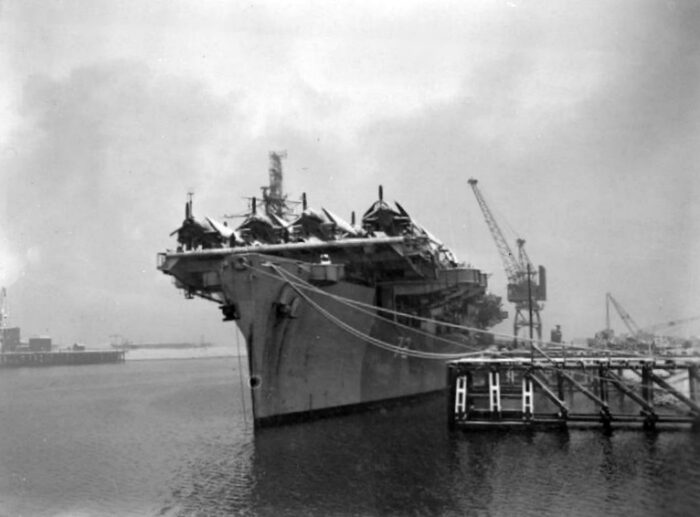
Ruler started as CVE50 St. Joseph at yard 45 Seattle-Tacoma, laid down on 25.3.1943, launched on 21.8.1943 and completed on 22.12.1943. After trials she was converted to British standards at Burrard Dry Dock in Vancouver as a transport carrier. She had fixes in Norfolk, and transisted Panama on 20 April 1944 with Hellcat and Corsair on board to deliver them to RNAS Speke, Liverpool on 6 May 1944. She sailed to New York, to take Avengers and Hellcat on 20-23 May 1944 for RNAS Speke, 11 June. Her third trip was for Hellcat and Corsair from Norfolk 20-29 October for Greenock, 18 November. She escorted convoys in the North Atlantic also and by early 1945 transferred to the Pacific for the raid on Truk and Okinawa from March to August 1945 with the British Pacific Fleet and 30th Aircraft Carrier Squadron. She was in Tokyo Bay on 31 August 1945. On 13 September she ferried back 450 POW to Sydney, 27 September. She was sent to Norfolk on 28 January 1946, decom. 29 January, for disposal, stricken 20 March 1946 sold for BU.
 HMS Arbiter (D31, R303)
HMS Arbiter (D31, R303)
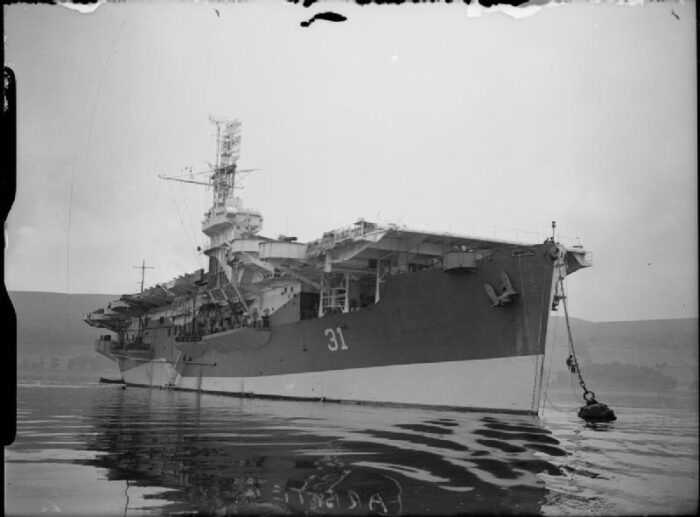
Arbiter was laid down as CVE51 St. Simon at yard 46 of Seattle-Tacoma on 26.4.1943, launched 9.9.1943 and completed on 31.12.1943. She did escort work and win battle honors for the Atlantic in 1944, notably on the western approaches and from 1945 as an aircraft ferry towards the British Pacific Fleet, bringing replacement aircraft and providing combat air patrol. She was retruend to the US in Norfolk on 23 February 1946, stricken 12 April 1946, sold at Newport News on 30 January 1947, converted as a merchant Coracero, later President Macapagal and Lucky Two in 1972, scapped in Taiwan the same day.
 HMS Smiter (D55, R321)
HMS Smiter (D55, R321)
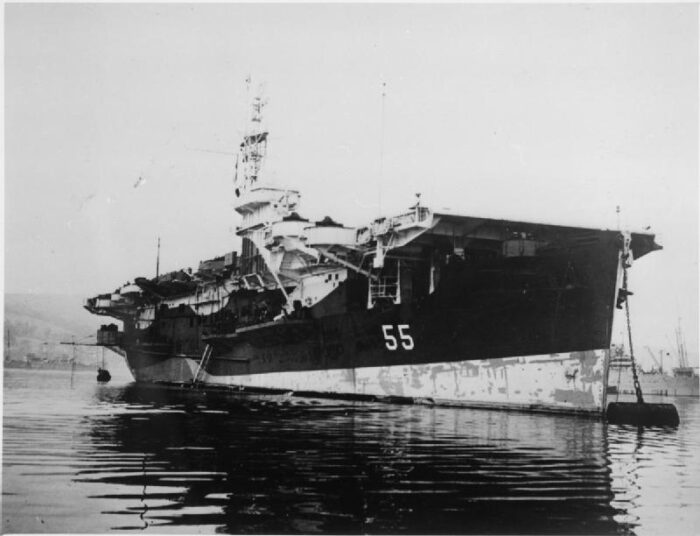
HMS Smiter was laid down as CVE52 Vermillion at yard 47 in Seattle-Tacoma on 10.5.1943, launched on 27.9.1943 and completed on 20.1.1944. She served as escort carrier first, then in 1945 as aicraft ferry for the BPF until the end of WW2. Returned at Norfolk on 20 March 1946, retransferred 6 April 1946, surplus, stricken 6 May 1946 resold on 28 January 1947 to Newport News and reconverted for the Compania Argentina de Navigacion Dodero, S.A. in 1948 as SS Artillero (later President Garcia in 1965). She was wrecked off Guernsey in July 1967, recovered and towed to Hamburg in November to be scrapped.
 Puncher (D79)
Puncher (D79)
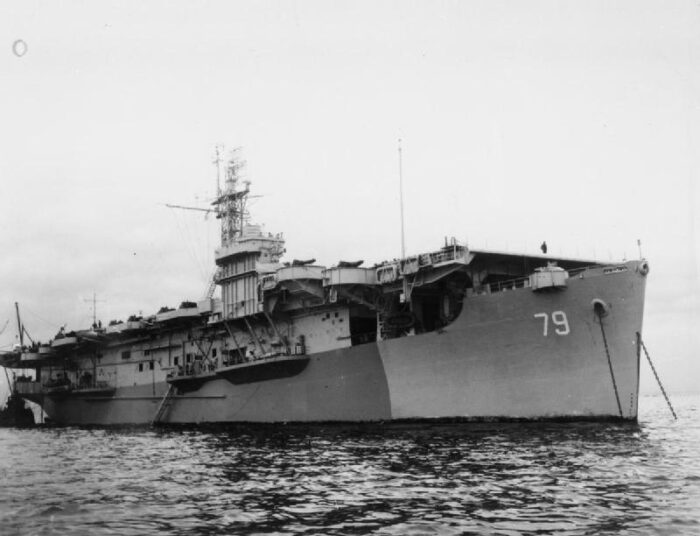
Started as CVE53 Willapa at yard 48 in Seattle-Tacoma she was laid down on 21.5.1943, launched on 8.11.1943 and completed on 5.2.1944. She was standardized to RN needs and as a transport carrier at Vancouver and then transferred to the Royal Canadian Navy alongside HMS Nabob. British flag and supervision but fully crewed by Royal Canadian Navy personnel. This arrangement went from a prevention to the Lend-Lease equipment being transferred to a third party.
She carried various cargoes between the Atlantic Ocean and Mediterranean Sea. In June 1944 she carried motor launches from New Orleans to New York. Then Army Air Force aircraft from Norfolk to Casablanca and back to Norfolk for more ferry trips, with Corsairs of the 1845 NAS. On 21 November 1944, she carried the 821 Naval NAS to the Clyde but needed repairs after a main gear failure. Nabob, meanwhile, torpedoed and declared a total constructive loss ceded hr gearbox, installed on Puncher. On 1 February 1945, HMS Puncher was in Scapa Flow to receive 881 NAS Wildcats and 821 NAS Barracuda for training. She launched airstrike and was used in convoy air protection (CAP), taking the place of HMS Nabob, decommissioned.
She covered six different Arctic convoys to Murmansk/Arkhangelsk and made strikes in German occupied Norway, notably on Narvik. On 11 February she covered a minelaying airstrike along the Norwegian coast. On 24 March she made an airstrike on Trondheim. On 25 June 1945, she became a repatriation troop transport with Canadian soldiers. Paid off on 16 February 1946 at Norfolk, stricken on 12 March 1946, she was sold on 4 Feb. 1947 to J. Chambers & Co as the mercantile Muncaster Castle in 1949, Bardic in 1954, then Ben Line Steamers in 1959 as Ben Nevis, scrapped in Kaoshiung, Taiwan from June 1973.
 HMS Reaper (D82, R324)
HMS Reaper (D82, R324)
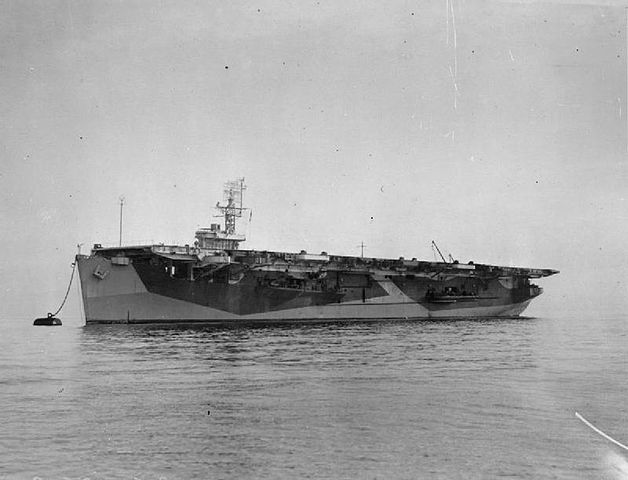
HMS Reaper started as CVE54 Winjah in yard 49 of Seattle-Tacoma on 5.6.1943, launched 22.11.1943 and completed on 21.2.1944. From March to August 1945 she served with the British Pacific Fleet, attached to the 30th Aircraft Carrier Squadron. Before ending her career, she brought from Cherbourg captured German Luftwaffe aircraft to the US in Operation Lusty like the sole jet bomber Arado Ar 234, Heinkel He 219, studied and preserved. The planes were flew to Querqueville Airfield ner Cherbourg. She sailed to Norfolk, Virginia, handed over on 13 May 1946, decommissioned on 20 May, returned, on disposal 14 June, stricken 8 July, sold to Waterman Steamship Company in Mobile, Alabama, 12 February 1947, reconverted as the South Africa Star, scrapped in Japan in May 1967.
Read More/Src
Books
Royal Navy Research Archive – Royal Navy Escort Carriers.
Ient, Victor (2020). These Valiant Men. Troubadour Publishing. p. 190.
Cocker, Maurice (2008). Aircraft-Carrying Ships of the Royal Navy. Stroud, Gloucestershire: The History Press.
J.Gardiner, Conway’s all the world’s fighting ships
Links
https://www.vintagewings.ca/stories/baby-flattops-of-the-royal-navys-ruler-class
https://www.worldnavalships.com/ruler_class.htm
https://uboat.net/allies/warships/ship/3290.html
http://www.navsource.org/archives/03/050.htm
http://www.navypedia.org/ships/uk/brit_cv_ameer.htm
https://www.royalnavyresearcharchive.org.uk/ESCORT/CLASSES.htm
https://www.royalnavyresearcharchive.org.uk/ESCORT/RULER.htm
https://ww2db.com/other.php?other_id=53
http://www.historyofwar.org/articles/weapons_ruler_class_escort_carriers.html
https://www.silverhawkauthor.com/post/royal-navy-warships-aircraft-carriers-hms-nabob-and-hms-puncher-manned-by-rcn-crews-1944-1945
https://en.wikipedia.org/wiki/Ruler-class_escort_carrier
http://www.hazegray.org/danfs/carriers/cve50.txt
https://www.history.navy.mil/content/dam/nhhc/research/histories/naval-aviation/evolution-of-aircraft-carriers/car-9.pdf
https://en.wikipedia.org/wiki/HMS_Ameer_(D01)
http://www.indianamilitary.org/FreemanAAF/Ships/HMS%20Reaper/HMS%20Reaper.htm
https://www.wartimes.ca/forums/viewtopic.php?t=95
https://commons.wikimedia.org/wiki/Category:Ameer_class_escort_carriers
http://www.wings-aviation.ch/32-FAA/2-Aircraft/Grumman-Avenger/bomber.htm
http://www.wings-aviation.ch/32-FAA/2-Aircraft/Grumman-Hellcat/fghter.htm
http://www.wings-aviation.ch/32-FAA/2-Aircraft/Grumman-Martlet/fighter.htm
Videos
Model Kits
None but a modified Bogue class could do. Query on scalemates
But also pit-road HMS Tracker

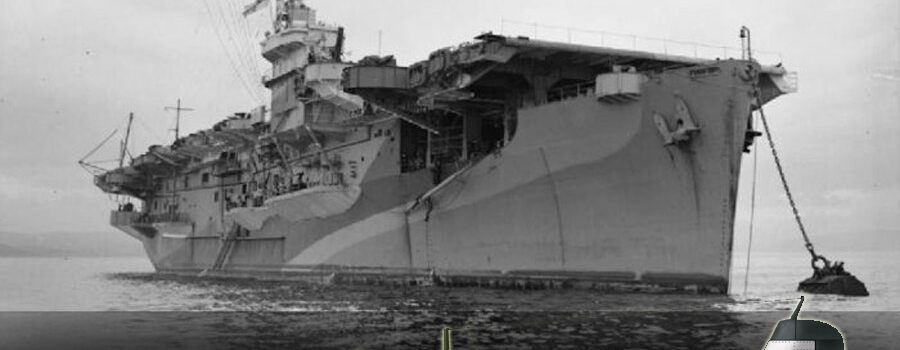
 Latest Facebook Entry -
Latest Facebook Entry -  X(Tweeter) Naval Encyclopedia's deck archive
X(Tweeter) Naval Encyclopedia's deck archive Instagram (@navalencyc)
Instagram (@navalencyc)





 French Navy
French Navy Royal Navy
Royal Navy Russian Navy
Russian Navy Armada Espanola
Armada Espanola Austrian Navy
Austrian Navy K.u.K. Kriegsmarine
K.u.K. Kriegsmarine Dansk Marine
Dansk Marine Nautiko Hellenon
Nautiko Hellenon Koninklije Marine 1870
Koninklije Marine 1870 Marinha do Brasil
Marinha do Brasil Osmanlı Donanması
Osmanlı Donanması Marina Do Peru
Marina Do Peru Marinha do Portugal
Marinha do Portugal Regia Marina 1870
Regia Marina 1870 Nihhon Kaigun 1870
Nihhon Kaigun 1870 Preußische Marine 1870
Preußische Marine 1870 Russkiy Flot 1870
Russkiy Flot 1870 Svenska marinen
Svenska marinen Søværnet
Søværnet Union Navy
Union Navy Confederate Navy
Confederate Navy Armada de Argentina
Armada de Argentina Imperial Chinese Navy
Imperial Chinese Navy Marinha do Portugal
Marinha do Portugal Mexico
Mexico Kaiserliche Marine
Kaiserliche Marine 1898 US Navy
1898 US Navy Sovietskiy Flot
Sovietskiy Flot Royal Canadian Navy
Royal Canadian Navy Royal Australian Navy
Royal Australian Navy RNZN Fleet
RNZN Fleet Chinese Navy 1937
Chinese Navy 1937 Kriegsmarine
Kriegsmarine Chilean Navy
Chilean Navy Danish Navy
Danish Navy Finnish Navy
Finnish Navy Hellenic Navy
Hellenic Navy Polish Navy
Polish Navy Romanian Navy
Romanian Navy Turkish Navy
Turkish Navy Royal Yugoslav Navy
Royal Yugoslav Navy Royal Thai Navy
Royal Thai Navy Minor Navies
Minor Navies Albania
Albania Austria
Austria Belgium
Belgium Columbia
Columbia Costa Rica
Costa Rica Cuba
Cuba Czechoslovakia
Czechoslovakia Dominican Republic
Dominican Republic Haiti
Haiti Hungary
Hungary Honduras
Honduras Estonia
Estonia Iceland
Iceland Eire
Eire Equador
Equador Iran
Iran Iraq
Iraq Latvia
Latvia Liberia
Liberia Lithuania
Lithuania Mandchukuo
Mandchukuo Morocco
Morocco Nicaragua
Nicaragua Persia
Persia San Salvador
San Salvador Sarawak
Sarawak Uruguay
Uruguay Venezuela
Venezuela Zanzibar
Zanzibar Warsaw Pact Navies
Warsaw Pact Navies Bulgaria
Bulgaria Hungary
Hungary

 Bundesmarine
Bundesmarine Dutch Navy
Dutch Navy Hellenic Navy
Hellenic Navy Marina Militare
Marina Militare Yugoslav Navy
Yugoslav Navy Chinese Navy
Chinese Navy Indian Navy
Indian Navy Indonesian Navy
Indonesian Navy JMSDF
JMSDF North Korean Navy
North Korean Navy Pakistani Navy
Pakistani Navy Philippines Navy
Philippines Navy ROKN
ROKN Rep. of Singapore Navy
Rep. of Singapore Navy Taiwanese Navy
Taiwanese Navy IDF Navy
IDF Navy Saudi Navy
Saudi Navy Royal New Zealand Navy
Royal New Zealand Navy Egyptian Navy
Egyptian Navy South African Navy
South African Navy






























 Ukrainian Navy
Ukrainian Navy dbodesign
dbodesign